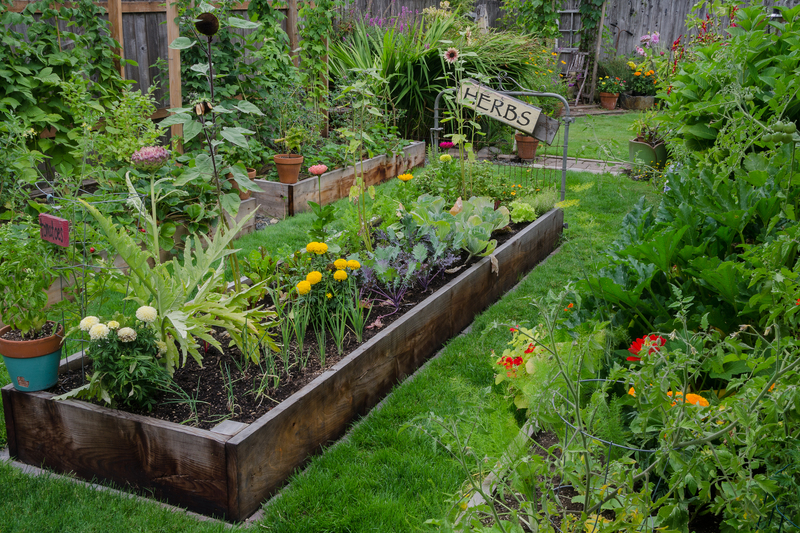Winning Against Summer Stress: Protect Your Lawn from Drought
Summer brings warmth, sunshine, and outdoor fun--for humans at least. Your lawn, on the other hand, faces relentless heat, intense sunlight, and reduced rainfall, creating the perfect recipe for drought stress. But with a strategic approach, you can rise above these challenges and protect your beloved lawn from drought. In this comprehensive guide, discover the most effective methods to maintain a resilient, lush, and green lawn through the hottest months of the year.
Understanding Summer Lawn Stress: Why Does Your Grass Suffer?
During summer, lawns battle against two main rivals: extreme heat and insufficient moisture. These culprits trigger what is known as summer lawn stress. Here's why:
- Evaporation rates increase: Hot temperatures cause the soil to lose water more rapidly than in cooler months.
- Water scarcity: Rainfall often decreases during summer, making it harder for grass roots to absorb the moisture they need.
- Grass goes dormant: When stressed, many grass types slow down their growth or even brown out to survive.
Protecting your lawn from drought means understanding these natural behaviors and countering them with proven strategies.

Identifying Signs of Drought Stress in Your Lawn
Early detection is key to winning against summer drought. Keep an eye out for these signs that indicate your lawn is under stress:
- Grass blades turn grayish or bluish: Instead of robust green, stressed lawns develop dull tones.
- Footprints linger: When you step on the lawn, footprints remain visible as the grass fails to spring back quickly.
- Slowed growth: Lawn requires mowing less often, indicating slowed metabolism due to drought stress.
- Curling or folding blades: Grass blades may roll or fold to conserve moisture.
Spotting these warning signs early gives you a head start to implement solutions before permanent damage occurs.
Expert Tips to Protect Your Lawn from Drought
The secret to a vibrant summer lawn lies in a proactive and holistic approach. Here are trusted and science-backed ways to ensure your lawn survives--and thrives--despite the heat.
1. Choose the Right Grass Type
Grass selection is the foundation for drought defense. Not all grasses are created equal--some fare better in heat and drought conditions.
- Warm-season grasses: Buffalograss, Bermuda, Zoysia, and St. Augustine naturally resist heat and recover from drought quickly.
- Tall fescue (cool-season): While a cool-season grass, tall fescue's deep roots offer better drought resistance than other cool-season varieties.
If establishing a new lawn or overseeding, opt for drought-tolerant varieties to set your yard up for summer success.
2. Master Smart Watering Techniques
Inefficient watering wastes resources and leaves your grass vulnerable. Adopt smart irrigation practices to help your lawn withstand drought:
- Water deeply but infrequently: Aim for 1 to 1.5 inches per week, delivered in a single session or divided into two, to encourage deep root growth.
- Water early in the morning: Early hours minimize evaporation and fungal diseases.
- Use efficient sprinklers: Opt for systems that deliver water close to the roots and adjust coverage to avoid runoff.
Remember: Short, frequent watering leads to shallow roots--making your grass more susceptible to drought.
3. Implement Proper Mowing Strategies
Mowing during drought can be tricky. The wrong approach will weaken your grass further. To protect your lawn from summer heat:
- Raise your mower blade: Allow the grass to grow taller (3-4 inches). Taller blades shade and cool the soil, reducing evaporation.
- Sharpen your mower blades: Clean cuts help grass recover from mowing. Dull blades tear grass, increasing stress.
- Avoid mowing in extreme heat: Mow during cooler parts of the day to lessen turf shock.
4. Fertilizing Wisely During Drought
Many homeowners mistakenly fertilize heavily in summer. However, fertilizing during drought can harm rather than help:
- Light feeding only: Apply a slow-release, balanced fertilizer at the start of summer if needed. Avoid over-fertilizing when drought stress is severe.
- Avoid "quick green-up" products: These push the grass to grow when resources are scarce--leading to burnout.
Tip: Focus on soil health instead. Add compost or organic materials in spring and fall to improve water retention and resilience.
5. Mulching and Grasscycling
Nature often knows best. Letting grass clippings stay on your lawn (grasscycling) acts as a natural mulch.
- Mulch benefits: Clippings shade the soil, slow down moisture loss, and return essential nutrients.
- Compost as mulch: Applying a thin layer of compost on your lawn helps water retention and adds organic matter, further boosting drought resistance.
6. Aeration: Combatting Soil Compaction
Compacted soil hinders water penetration and root growth, making lawns more vulnerable to summer drought.
- Core aeration: Use a core aerator to remove small plugs of soil, improving air, water, and nutrient flow.
- Timing: Aerate in spring or early fall before summer drought hits for best results.
7. Limit Lawn Traffic
During periods of drought stress, grass is at its most fragile.
- Minimize foot traffic: Use pathways or step stones in high-traffic areas to avoid compacting soil and crushing delicate grass.
- Delay heavy activities: Postpone sports, furniture placement, or events on the lawn until recovery is underway.
8. Use Wetting Agents in Extreme Drought
For lawns suffering from "hydrophobic" soil (where water beads off and won't soak in), consider specialty wetting agents. These products help water penetrate dry soil, ensuring roots get the moisture they need.
The Science Behind Drought Resistance in Lawns
Why do some lawns rebound from drought while others struggle? It comes down to these factors:
- Root depth: Lawns with deeper roots resist summer drought by tapping into moisture stored deep in the soil.
- Soil quality: High organic matter improves water retention, feeding beneficial microbes and supporting healthy turf.
- Grass type and genetics: Varieties developed for drought resistance thrive even during prolonged dry spells.
By focusing on these characteristics, you can future-proof your lawn against heat and water shortages.
Common Mistakes When Protecting Your Lawn from Drought
Many well-intentioned homeowners sabotage their efforts with these common pitfalls:
- Overwatering: Too much water can cause shallow roots, runoff, and disease.
- Watering during midday: High temperatures lead to rapid evaporation, wasting precious water.
- Mowing too short ("scalping"): Increases soil temperature, exposes roots, and accelerates drought damage.
- Ignoring soil health: Poor, compacted soils quickly dry out, making drought stress inevitable.
Avoid these errors to maximize your lawn's summer stamina.
Sustainable Lawn Care: Winning Against Future Droughts
Given climate variability and shifting weather patterns, protecting your lawn from drought should be an ongoing priority. Here's how you can embrace sustainable lawn care for long-term resilience:
Install Smart Irrigation Systems
- Weather-based controllers: Adjust watering schedules automatically according to rainfall and temperature.
- Soil moisture sensors: Deliver water only when your lawn truly needs it--no more wasteful irrigation.
Invest in Soil Improvement
- Annual topdressing: Apply fine compost or organic matter every year to enhance soil structure and water-holding capacity.
- pH Testing and correction: Ensure soil pH supports nutrient uptake and drought resilience.
Practice Lawn Alternatives
- Xeriscaping: Replace parts of your lawn with drought-tolerant ground covers, ornamental grasses, or native plants.
- Blended landscapes: Combined grass areas with shrubs, trees, or mulched beds for a water-wise yard.

FAQs: Winning Against Summer Lawn Drought
-
Q: Should I let my lawn go brown during severe drought?
A: Most cool-season grasses can survive a brown, dormant phase and recover when moisture returns. If restrictions are in place, reduce watering but avoid heavy foot traffic to prevent permanent damage. -
Q: Is it okay to fertilize a drought-stressed lawn?
A: Avoid fertilizing during peak drought. Wait until the lawn has greened up again and started growing before applying nutrients. -
Q: How do I know if my soil is hydrophobic?
A: If water pools or runs off without soaking in, your soil may have become water-repellent. Wetting agents or organic mulches can resolve this. -
Q: Can I revive a dead-looking lawn after drought?
A: Dormant lawns usually recover. Water gradually, mow high, and avoid heavy traffic. Severely damaged areas may require reseeding or renovation.
Conclusion: Your Path to a Drought-Proof Summer Lawn
Winning against summer stress and protecting your lawn from drought is about preparation, observation, and proactive care. With the right cultural practices, lawn care products, and smart irrigation, you can maintain a vibrant, resilient, and healthy lawn even under scorching summer conditions.
Start today--choose drought-tolerant grasses, improve your soil, water wisely, and embrace sustainable lawn care. Not only will your lawn thank you, but you'll also save water, time, and money in the long run. Ensure your yard is the envy of the neighborhood, even during the hottest, driest months.
Remember, a little effort now leads to a lush green oasis all summer--and for years to come!